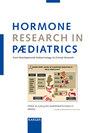Diagnostic Conundrum of a Sertoli Cell Tumor in a 2-Year-Old Girl with Peripheral Precocious Puberty and a Café-Au-Lait Macule: A Case Report.
IF 2.6
3区 医学
Q3 ENDOCRINOLOGY & METABOLISM
引用次数: 0
Abstract
INTRODUCTION Ovarian Sertoli cell tumors represent a subset of sex cord-stromal tumors and are exceedingly rare in prepubertal children. Here we report a girl with vaginal bleeding due to a Sertoli cell tumor who was originally thought to have McCune-Albright syndrome (MAS). CASE PRESENTATION A previously healthy girl presented at age two years six months with breast development and vaginal bleeding. On exam, she had Tanner 4 breasts, Tanner 1 pubic hair, estrogenized vaginal mucosa, and a café-au-lait macule. Laboratory studies revealed an elevated estradiol with suppressed gonadotropins and negative tumor markers. Her bone age was advanced by more than three years. Pelvic ultrasound (US) revealed an enlarged uterus and a slightly larger left compared to right ovary. She was started on tamoxifen for presumed MAS. A repeat pelvic US one month later showed a heterogenous mass in the left ovary which was subsequently resected. Pathology revealed a Sertoli cell tumor, lipid-rich variant. Germline sequencing revealed a pathogenic STK11 variant, diagnostic for Peutz-Jeghers syndrome (PJS). CONCLUSION The findings in our patient were strikingly similar to those encountered in MAS. To our knowledge, our patient is the youngest ever reported to present with precocious puberty due to a Sertoli cell tumor in the setting of PJS.患有外周性早熟和咖啡斑的 2 岁女孩的 Sertoli 细胞瘤诊断难题:病例报告。
导言卵巢Sertoli细胞瘤是性索间质肿瘤的一个分支,在青春期前的儿童中极为罕见。在此,我们报告了一名因 Sertoli 细胞瘤导致阴道出血的女孩,她原本被认为患有麦库那-阿尔布莱特综合征(McCune-Albright Syndrome,MAS)。病例介绍 一名原本健康的女孩在两岁六个月时出现乳房发育和阴道出血。经检查,她的乳房为坦那4型,阴毛为坦那1型,阴道粘膜雌激素化,并有咖啡色黄褐斑。实验室检查显示雌二醇升高,促性腺激素受到抑制,肿瘤标志物阴性。她的骨龄提前了三年多。盆腔超声(US)显示子宫增大,左侧卵巢比右侧卵巢稍大。她开始服用他莫昔芬来治疗假定的 MAS。一个月后,她再次接受盆腔超声检查,发现左侧卵巢有一个异质肿块,随后将其切除。病理结果显示,这是一种富含脂质的变异型 Sertoli 细胞肿瘤。种系测序发现了一个STK11致病变体,可诊断为Peutz-Jeghers综合征(PJS)。据我们所知,我们的患者是史上最年轻的因Sertoli细胞肿瘤而导致性早熟的PJS患者。
本文章由计算机程序翻译,如有差异,请以英文原文为准。
求助全文
约1分钟内获得全文
求助全文
来源期刊

Hormone Research in Paediatrics
ENDOCRINOLOGY & METABOLISM-PEDIATRICS
CiteScore
4.90
自引率
6.20%
发文量
88
审稿时长
4-8 weeks
期刊介绍:
The mission of ''Hormone Research in Paediatrics'' is to improve the care of children with endocrine disorders by promoting basic and clinical knowledge. The journal facilitates the dissemination of information through original papers, mini reviews, clinical guidelines and papers on novel insights from clinical practice. Periodic editorials from outstanding paediatric endocrinologists address the main published novelties by critically reviewing the major strengths and weaknesses of the studies.
 求助内容:
求助内容: 应助结果提醒方式:
应助结果提醒方式:


